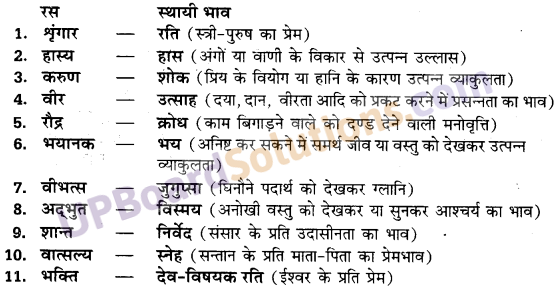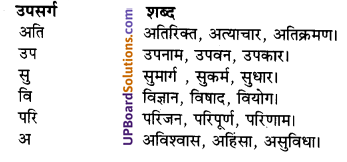UP Board Solutions for Class 10 Commerce Chapter 2 Final Accounts with Simple Adjustments
Final Accounts with Simple Adjustments Objective Type Questions (1 Mark)
Question 1.
Outstanding wages is shown in: (UP 2014)
(a) Debit side of trading account
(b) Debit side of P & L Account
(c) Liability side of Balance Sheet
(d) Asset side of Balance Sheet.
Answer:
(a) Debit side of trading account
Question 2.
Income earned but not received is termed as:
(a) Accrued Income
(b) Income Received in Advance
(c) Either (a) or (b)
(d) None of these.
Answer:
(a) Accrued Income
Question 3.
The Depreciation figure provided under Trial Balance shall find place under ………..
(a) Balance Sheet
(b) Trading Account
(c) Profit and Loss Account
(d) None of these
Answer:
(c) Profit and Loss Account
![]()
4. The amount of closing stock given under Trial Balance shall find place in ………
(a) Trading Account
(b) Profit and Loss Account
(c) Balance Sheet
(d) None of these.
Answer:
(c) Balance Sheet
Question 5.
……….. is a income which has been received but has not been earned.
(a) Depreciation
(b) Unearned Income
(c) Accrued Income
(d) Interest.
(b) Unearned Income
Final Accounts with Simple Adjustments Definite Answer Type Questions (1 Mark)
Question 1.
What term is used for the wear and tear caused to the fixed assets due to their continuous use?
Answer:
Depreciation.
Question 2.
What term is used for the amount drawn from the business by proprietor for personal use?
Answer:
Drawings.
![]()
Question 3.
What term is used for the goods which remain unsold at the end of the Financial Year?
Answer:
Closing Stock.
Final Accounts with Simple Adjustments Very Short Answer Type Questions (2 Marks)
Question 1.
What kind of items are treated as Adjustments?
Answer:
All such transactions which are related (UPBoardSolutions.com) to the period of final accounts but are not in Trial Balance as they are unrecorded in the books of accounts and the transactions which are recorded but are not concerned with the period of final accounts but one included in Trial Balance are treated as adjustments.
Question 2.
What is meant by Adjustments? (UP 2017)
Answer:
Adjustments imply to adjust or present the figures drawn from ledger by following accounting principles and postulates, in such manner that when they included in final accounts it would reveal the true and fair view of a business.
Question 3.
What is meant by the term ‘Provision’?
Answer:
The term ‘provision’ means an amount retained in order to provide domination in the value of and, or to provide for any known liability whose amount cannot be ascertained correctly.
![]()
Question 4.
Write two items which are written in the credit side of profit and loss account? (UP 2015, 18)
Answer:
There are two items which are written in the credit side of profit and loss account:
- Receipt on Intrest
- Receipt on Rent.
Final Accounts with Simple Adjustments Short Answer Type Questions (4 Marks)
Question 1.
Give the importance of adjustment entries while preparing the Final Accounts.
Answer:
The adjustments are important in view of the fact that in order (UPBoardSolutions.com) to arrive at an accurate figure of the actual net profit earned or net loss sustained during any particular Financial Year, it is necessary to see that only items at expenses or gains relating to the particular financial year are brought into the profit and loss account.
Question 2.
Distinguish between accrued and unearned incomes?
Answer:
Difference between Accrued and Unearned Income:
| Accrued Income | Unearned Income |
| 1. The income which is earned by the businessman before the date of preparation of Final Account but not received is called Accrued Income. | 1. The income which is not earned by the businessman before the date of preparation of Final Accounts but is received before such date is called unearned income. |
| 2. This income is shown at the credit side of profit and loss account by adding it to the concerned head of income. | 2. This income is also shown at the credit side of profit and loss account but by deducting it from the concerned head of income. |
| 3. This income is shown on the Assets side of the Balance Sheet. | 3. This income is shown on the Liabilities side of the Balance Sheet. |
![]()
Question 3.
Distinguish between outstanding expenses and prepaired expenses.
Answer:
Difference Between Outstanding Expenses and Prepaired Expenses:
| Outstanding Expenses | Prepaired Expenses |
| 1. These are those expenses for which services had been received but not paid till the last accounting period or preparation of final accounts. | 1. These are those expenses for which services had not been received but are paid well in advance. |
| 2. These expenses are shown at the debit of Trading or Profit and Loss Account by Adding them to the concerned expense. | 2. These expenses are shown at the credit of trading or profit and loss account by deducting them from the concerned expense. |
| 3. Outstanding expenses are shown at the liabilities side of the Balance Sheet. | 3. Prepaid expenses are shown at the Assets side of the Balance Sheet. |
| 4. Outstanding Expenses are concerned with the current financial year i.e., for which final accounts are prepared. | 4. Prepaid expenses are concerned with the next Financial years i.e., the year following the year for which final accounts are prepared. |
Final Accounts with Simple Adjustments Long Answer Type Questions (8 Marks)
Question 1.
What do you understand by Adjustment? Explain the kinds of general adjustments. (UP 2002, 13)
Or
What do you understand by Adjustments? Write about any six kinds of it. Give its Journal Entry also. (UP 2012)
Or
From the following adjustment show any five of them in Profit and Loss A/c and the Balance Sheet after recording their journal entries:
(i) Prepaid Insurance
(ii) Unearned Income
(iii) Interest on Drawings
(iv) Bad Debts
(v) Depreciation
(vi) Outstanding Salaries
(vii) Interest on Capital
(viii) Provision for Discount on Debtors. (UP 2002)
Or
Discuss ten types of adjustment entries to he made while preparing Final Account. Give its journal entries also. (UP 2004)
Or
What is meant by Adjustment entries? Make adjustment journal entries of the following:
(i) Depreciation on Machinery
(ii) Outstanding Expenses
(iii) Prepaid Expenses
(iv) Accrued Income
(v) Reserve for Doubtful Debts
(vi) Unearned income
(vii) Closing stock. (UP 2005, 10)
Or
What are the types of adjustment entries? Journalise the following adjustment with imaginary amount:
(i) Reserve for discount on creditors
(ii) Interest on drawings. (UP 2005)
Or
Write about any four adjustments carried in the final account. Pass Journal Entries for them also. (UP 2014)
Answer:
Meaning of Adjustments: At the end of the financial period every trader prepares the final accounts in which all the expenses and incomes related to the current trading period are included. But it generally happens that certain expenses relating to a trading period do not appear in the books of that financial period. On the other hand, it also happens that expenses (UPBoardSolutions.com) under certain heads, such as Insurance, Telephone Subscription etc. are paid for a year well in advance. It is necessary to scrutinize carefully all items of expenditure to ascertain that all expenses paid or unpaid but relating to the period of trading are brought into books of accounts.
![]()
If any item of expenditure is paid for in advance, the same must be properly apportioned between the period, that has already expired and the period that is yet to expire so that proper adjustments may be made in this respect. All items of gains will also have to be similarly scrutinized to see all gains relating to the period whether received or accrued are brought into account.
Thus, all such transactions which are related to the period of final accounts but are not in Trial Balance as they are unrecorded in the books of accounts and the transactions which are recorded but are not concerned with the period of final accounts but are included in Trial Balance are treated as adjustments.
Meaning of Entries for Adjustments: The entries which are made for the adjustments are called entries for adjustments.
Preparing of Amended Trial Balance: When entries for adjustments are made, it, makes a change in the accounts already opened and some new accounts are also opened which diminishes the purpose served by already prepared Trial Balance. The old Trial Balance does not serve its purpose. Thus an Amended Trial Balance is prepared in which entries for adjustments are also taken into account. On the basis of Amended Trial Balance, the final accounts Eire prepared.
Important Adjustments: The adjustments are important in view of the fact that in order to arrive at Em accurate figure of the actual net profit earned or net loss sustained during any particular financial year, it is necessary to see that (UPBoardSolutions.com) only items of expenses or gains relating to the particular financial year are brought into the Profit and Loss Account. The following are the main adjustments usually made in the books of account:
- Closing Stock.
- Outstanding Expenses.
- Prepaid Expenses.
- Accrued Incomes.
- Unearned Incomes.
- Depreciation.
- Appreciation.
- Interest on Capital.
- Interest on Drawings
- Bad Debts.
- Reserve for Bad and Doubtful Debts
- Reserve for a discount on Debtors
- Reserve for a discount on Creditors.
![]()
Closing Stock: The goods which remain unsold at the end of a financial year are termed as Closing Stock. The unsold stock of goods should never be valued at selling price if that price exceeds cost price. If the market price is less than cost price, then the stock is valued at the market price. When the market price is less than cost price then a loss has evidently been incurred, since the goods can only be sold at loss. It should be remembered that closing stock should be valued at market price or cost price whichever is less. The figure of closing stock is shown on the credit side of the Trading Account in order to ascertain the Gross Profit. The amount of closing stock is also shown on the Assets side of the Balance Sheet.
Outstanding Expenses: The prevalent practice in modern business is that rent, salaries, wages, interest, etc. of each month are paid in the subsequent months. Suppose, the trading period of a business ends on 31st March, it would follow that the office rent, staff salaries, wages, interest, etc. for the month of March, not having been paid in that month, will not appear in the (UPBoardSolutions.com) books for the period ended on 31st March, and yet, as expenses under these heads have been incurred and as they belong to the current financial year ending on 31st March, it is necessary that they should be charged to Trading or Profit and Loss Account of the particular financial year.
Such an adjustment is made by means of a journal entry debiting the various nominal accounts concerned with the amounts due and crediting an account called ‘Outstanding Expenses’. The Outstanding Expenses will appear as a liability in the liability side of the Balance Sheet. In the next trading period when these expenses are paid off, then Outstanding Expenses Account is debited and cash account is credited.
Prepaid Expenses: Where the expenses have been paid in advance, the nominal account concerned should be adjusted, so that the proportionate amount applicable to the period of trading only may be charged off to the Trading or Profit and Loss Account as expenses for the particular year and the amount paid in advance is shown in the Balance Sheet as Em asset under the heading ‘Prepaid Expenses’.
Example: Insurance premium, Telephone subscription, Advance rent, Advance expenses, etc.
The journal entry passed for adjusting the amount is Prepaid expenses should be debited and the nominal account concerned must be credited. The prepaid expenses account is an asset as it represents a pre-payment in respect of which some benefit is yet to be received.
Accrued Income: Income which has been earned but not received is termed as ‘Accrued Income’. If any item of income such as Rent receivable, Interest on Securities, Interest on Loan, Commission, Discount etc. is earned and belongs to the financial period but not received then it is necessary that all such incomes relating to that financial period should be shown in the accounts.
The necessary adjustment for the purpose of bringing such accrued incomes into account should, therefore, be made by means of a journal entry debiting accrued, income account and crediting the source of income. The debit to accrued income account will appear as an asset in the Balance Sheet.
Unearned Income: Unearned Income is an income which has been received it has not been earned. Suppose, if, in any financial year, businessman receives some money and in respect of which full services have not been rendered by him. The amount for which service has not been provided is to be treated as a liability. A journal entry is passed for the amount received in respect of which the service still remains to be rendered. The nominal account concerned is debited and an account styled as Unearned (UPBoardSolutions.com) Income is credited. This credit balance on the latter account is shown as a liability in the Balance Sheet. At the commencement of the coming financial year, the above entry would be reversed.
Depreciation: The term Depreciation means a permanent decline in value of the asset due to wear and tear or from any other cause. All assets have either a definite or an estimated period of utility to the business in which they are employed and as the years pass by, their measure of usefulness diminishes or declines with the result that they have to be discarded when they become useless. The loss sustained by way of depreciation should be charged to the Profit and Loss Account each year otherwise final accounts will fail to show the true facts of the business.
![]()
The depreciation arising from the use of the assets should be charged in the period to which it relates, irrespective of whether a profit or loss has been made. The journal entry for writing off depreciation on any asset is to debit Depreciation account and credit the respective Asset account. The effect of such an entity would be that it will reduce the book value of the asset and the loss is charged to the Profit and Loss Account.
Appreciation: When a country faces problems such as drought, plague or war then the Government of the country circulates extra currency to overcome the prevailing problems. The purchasing power of money is reduced by the extra circulation of money and prices of various commodities and assets begin to rise. Appreciation in value of assets is again for the business and is shown on the credit side of the Profit and Loss Account and the assets are shown by the appreciated value in the Balance Sheet.
Interest on Capital: A businessman expects his business to yield a much better return on the capital employed than it would have earned if the same amount was invested in other securities. This is because of the extra risk and efforts involved in carrying out the business. In order to find out, whether the business has really yielded any profit in excess of the current rate of interest, he charges that interest to Profit and Loss Account and credit the same to his Capital Account. The interest on capital paid is loss or can be said an expense for the business and a gain to the owner himself.
If any such interest is to be adjusted at the end of the financial year, journal entry has to be passed debiting interest account and crediting the Capital Account of the owner with the amount of interest to be paid.
Interest on Drawings: A businessman often draws some money out of his business to meet out his personal expenses. Such withdrawals reduce his capital balance in the business. In some cases, such drawings are debited to (UPBoardSolutions.com) a separate account called ‘Drawings Account’ and this account is then closed by transfer to the capital account at the end of each financial year.
Interest on drawings are calculated from the date of withdrawal till the end of the financial period, and amount thus ascertained is debited to the Capital Account and credited to the Interest Account. The owner is thus charged with interest on the sum withdrawn for meeting out his personal expenses.
Bad Debts: In modern business, most of the transactions are done on a credit basis. Whether it is a small businessman or a big business house all have a major percentage of credit transactions in the business.
It’s a common feature in the business that some of the debtors fail to pay their debts in full. The debts which are irrecoverable from the debtors are called ‘Bad Debts’. Tfie journal entry to write off Bad Debts would be to debit Bad Debts Account and credit the Personal Account of the customer who has failed to pay. The debit balance of Bad Debts Account represents a loss and is transferred to the Profit and Loss Account.
If the amount of Bad Debts appears in Adjustment Entries then Profit and Loss Account is debited with the amount and the same is deducted from the Debtors in the Balance Sheet.
Reserve for Bad and Doubtful Debts: After writing off all known Bad Debts, the businessman tries to find out the list of those customers from whom payment may be doubtful. Such debts are called Doubtful Debts, and in order to arrive at an accurate figure of the net profit made in any particular financial year, it is necessary to provide for Doubtful Debts. This is done by estimating the further less likely to be sustained on the recovery of Book Debts and a journal entry is passed, debiting the Profit and Loss Account and crediting Reserve for Bad and Doubtful Debts Account.
![]()
The credit balance of Reserve for Bad and Doubtful Debts Account is shown in the Balance Sheet as a deduction from the net amount of Sundry Debtors i.e., the amount arrived after deducting the amount of bad debts from debtors so that the net estimated realisable amount from Sundry Debtors may be shown in outer column of the Balance Sheet.
If the amount of Bad Debts equals the amount of reserve made in that period, then correct profit or loss is ascertained. If there is any balance left in Reserve for Bad and Doubtful Debts Account then the same is shown as a profit on the credit side of the Profit and Loss Account. In the next financial year, the balance of the reserve is known as Old Reserve. If Bad Debts and Old Reserve for Bad and Doubtful Debts are given in the Trial Balance and if some reserve is to be made on Debtors for the present financial year, then the number of Bad Debts and the amount of New Reserve will be added. The amount of Old Reserve for Bad and Doubtful Debts will be deducted from the above amount arrived and the balance will be shown on the debit side of the Profit and Loss Account.
When the balance of Old Reserve for Bad and Doubtful Debts is more than the total of Bad Debts and Reserve for Bad and Doubtful debts then old balance is shown on the credit side of the Profit and Loss Account (UPBoardSolutions.com) and Bad Debts plus new Reserve are shown on the debit side of the Profit and Loss Account. The amount of New Reserve is deducted from the debtors in the Balance Sheet.
Reserve for a discount on Debtors: In modern times as most of the business transactions are done on a credit basis, the trader gives some incentive in the form of discount to his customers for early realisation of payments. The loss arising due to discount to be allowed will be estimated and brought into accounts. This will help in showing the exact realisable amount from customers in the Balance Sheet.
At the end of each financial year, therefore, it becomes necessary to estimate this loss of discount that will have to be allowed to the customers, and make a provision in this respect. The provision is made by way of a certain percentage being calculated on Sundry Debtors at the close of the financial year and by debiting the Discount Account and crediting the Reserve for Discount Account. The credit balance of Reserve for Discount Account is shown by deducting the same from the number of Sundry Debtors in the Balance Sheet.
If both Reserve for Bad and Doubtful Debts and Reserve for Discount are to be made, then first Reserve for Bad and Doubtful Debts is made and after deducting the same from the amount of the Sundry Debtors, the Reserve for Discount is made on the balance amount of the Sundry Debtors remaining after deduction of the Reserve for Bad and Doubtful Debts. Both the reserves Eire shown on the debit side of the Profit and Loss Account and are deducted from the Sundry Debtors in the Balance Sheet. Discount cannot be given to those customers from whom payment is doubtful.
Question 2.
From the following trial balance extracted from the books of Sonal International Ltd., prepare Trading & Profit and Loss account for the year ended on 30th June 2011 and a Balance Sheet as on that date:

Adjustments:
(i) The closing stock was valued at Rs. 8,000.
(ii) Outstanding expenses; Salaries Rs. 500; Taxes Rs. 200.
(iii) The insurance premium is paid for the year 2011.
(iv) Provide interest on capital at 5% and on drawings Rs. 40.
(v) Depreciate furniture at 5% and Plant & Machinery by 10%.
Solution:

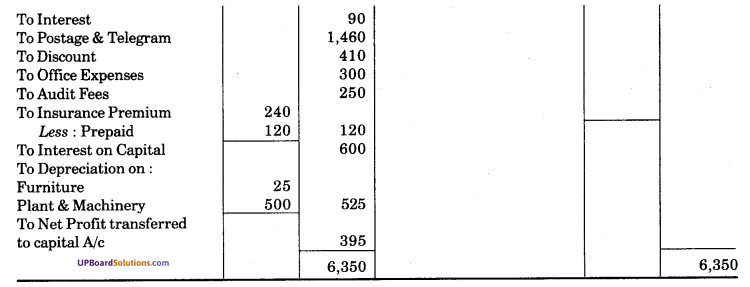
![]()

Question 3.
List the items to be shown at the debit and credit side of the trading account.
Answer:
Items which are shown at the Debit side of Trading Account:
- Opening Stock: This is the closing stock of the previous year.
- Purchases: This is the total of cash and credit purchases made during the year.
- Purchases Return: The goods which are returned back from purchased (UPBoardSolutions.com) goods are called purchase return. This amount is deducted from the number of purchases.
- Direct Expenses: These are the expenses which are essential for undertaking the work of production or for the procurement of goods such as octroi, freight, cartage, wages, power, collect.
Items which are shown at the Credit side of Trading Account:
- Sales: This is the total of cash and credit sales made during the year.
- Sales Return: The goods which are returned by the customers due to some reasons are known as sales return. The value of these goods is deducted from the number of sales.
- Closing Stock: The goods which remain unsold at the end of the financial year is called closing stock. This stock of goods is valued at cost price or market price whichever is less.
![]()
Question 4.
Give journal entries for the following adjustments and show them in the balance sheet as on that date: (UP 2016)
(a) Outstanding salaries Rs. 300 and Rent Rs. 200.
(b) The cost of the building is Rs. 1,00,000. Plant and Machinery are Rs. 80,000 (UPBoardSolutions.com) and furniture are Rs. 2,000. Provide depreciation at the rate of 5%.
Solution:


Question 5.
From the following Trial Balance prepared from the books of M/s Sunil Brothers for the year ending 31st December, 2011:

Prepare Trading and Profit and Loss Account for the year ending 31st December 2011 and the Balance Sheet as on that date with the following adjustments:
(i) Closing Stock was worth ₹ 4,000.
(ii) Charge 5% depreciation on Buildings.
(iii) Make provision for reserve for bad and doubtful debts @ 5% on Sundry Debtors.
(iv) Prepaid insurance premium ₹ 50.
(v) Unpaid expenses: Salary ₹ 100 and Wages ₹ 140.
Solution:


Question 6.
From the following Trial Balance, prepare Trading Account, Profit and Loss Account for the year ending 31st December, 2011 and the Balance Sheet on that date:
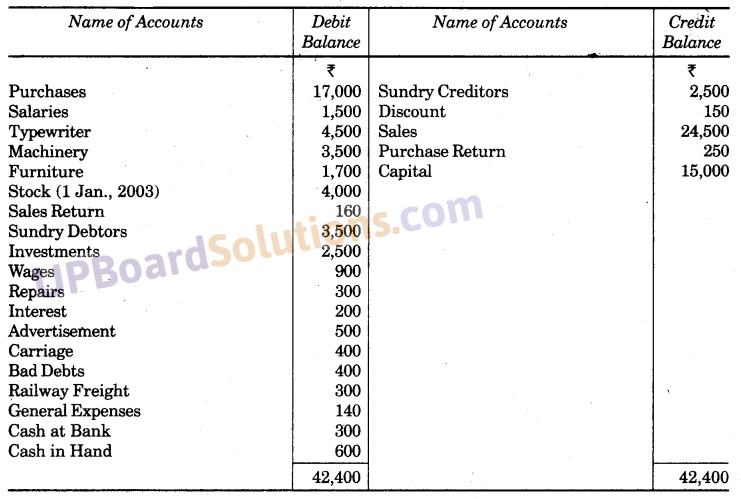
![]()
Adjustments:
(i) Depreciate machinery by 10% and typewriter by 5%.
(ii) Make a reserve @ 5% on sundry debtors for bad and doubtful debts.
(iii) Outstanding expenses—salaries ₹ 100 and wages ₹ 100.
(iv) Value of closing stock as on 31st December 2011 was ₹ 8,000.
Solution:

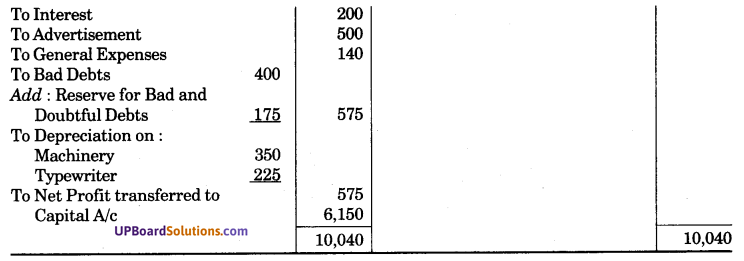

Question 7.
What is the method of accounting for the following adjustment:
(a) Outstanding expenses
(b) Prepaid expenses,
(c) Depreciation
(d) Closing stock
(e) Bad debts.
Answer:

Question 8.
(a) Rs. 3,000 is to be received as rent. Received Rs. 50 in advance. Give journal entry and show it in the balance sheet.
(b) Give journal entry to show its effect in the balance sheet for the following: Capital is Rs. 50,000, Rs. 5,000 are withdrawn by the proprietor for personal purposes. Interest at the rate of 6% is to be charged.
Answer:


![]()
Question 9.
Prepare Trading and Profit and Loss Account and Balance Sheet of M/s Ram Lai and Sons on 31st December 2011 from the following Trial Balance:

Adjust the following items:
(a) Closing Stock Rs. 9,900.
(b) Depreciate Land and Building @ 5%.
(c) Make a Provision for Bad and Doubtful Debts on Debtors @ 4%.
Solution:
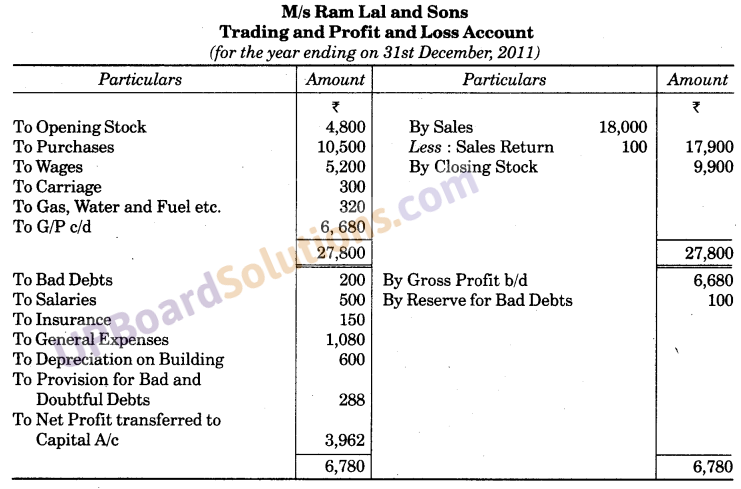
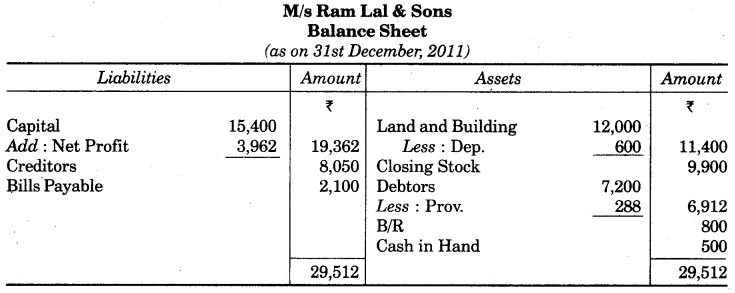
Question 10.
Pass adjustment entries for the following:
(i) Closing stock Rs. 5,000
(ii) Provision for bad debts @ 5% on Debtors of Rs. 50,000.
(iii) Provision for discount on debtors @ 2% on above (ii).
(iv) Provision for discount on creditors @ 2[latex]\frac { 1 }{ 2 }[/latex] on Rs. 40,000.
(v) Depreciation machinery worth Rs. 20,000 @ 10%.
Solution:
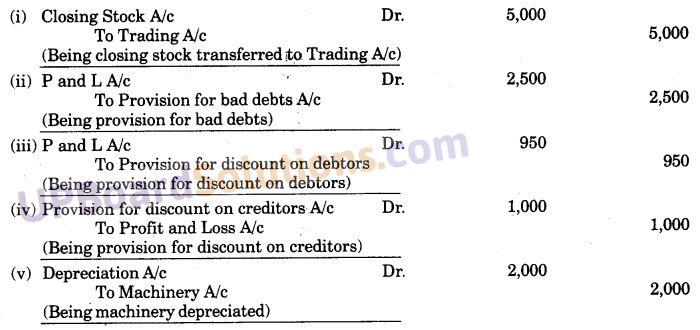
Question 11.
Explain any five items to be included in Trading A/c.
Answer:
- Opening Stock: This is the value of stock in hand on the first date of the accounting period. This item is shown in the debit side of the Trading Account. This is same as the closing stock of the last accounting period.
- Wages: Wages paid to the labourer directly involved in production work is shown in the debit side of the balance sheet.
- Freight Inward: Freight and cartage paid on carrying the raw material and consumables to the factory site are shown under such head in the debit side of Trading Account.
- Octroi: Octroi is a local tax to be paid to the local government. This is imposed on produced goods or carrying raw material. This item is debited in Trading Account.
- Salary of Factory Manager: If any production manager is appointed in the factory, his salary will also be shown in Trading Account.
![]()
Question 12.
From the following Trial Balance, prepare Trading Account and Profit and Loss Account for the year ending on 31st March, 2014 and Balance Sheet as on that date: (UP 2018)
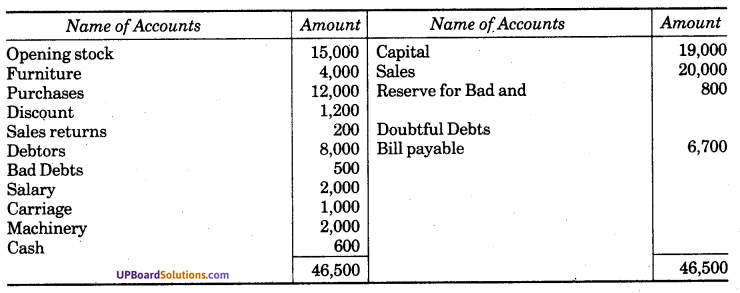
Adjustments:
(i) Closing stock Rs. 1,500
(ii) Depreciate machinery @ 5% p.a.
(iii) Make provision for bad and doubtful debts on debtors @ 5%.
(iv) Make reserve for discount on debtors @ 2%.
(v) Outstanding salary is Rs. 200.
Solution:


Question 13.
Prepare Trading Account, Profit and Loss Account for the year ending on 31st December, 2007 and Balance Sheet as on that date of M/s Raman and Brothers from the following Trial Balance:
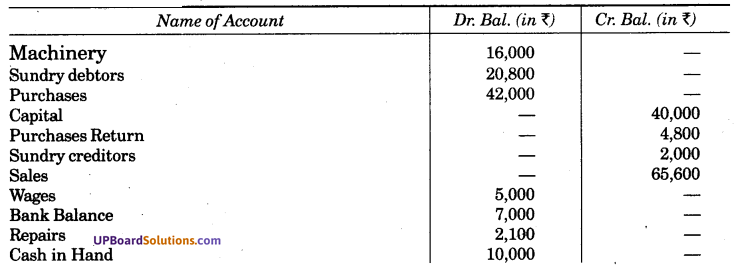

Value of closing stock on 31st Dec. 2007 was Rs. 12,000. Rs. 1,000 is to be provided as depreciation on machinery. Interest on capital is to be provided at 5%. Rs. 100 is to be paid for the repair. (UP 2008)
Solution:


Question 14.
From the following Trial Balance of M/s Mani Ram Dhani Ram Kolkata, prepare Trading Account. Profit and Loss Account for the year ending on 31st December 2008 and its Balance Sheet as on that date:

Adjustments:
(i) Closing Stock (31.12.2008): Rs. 19,900.
(ii) Depreciation on Furniture @ 10%: on Motor car @ 20% and on Building @ 10%.
(iii) Reserve for Bad Debts on debtors @ 5%. (UP 2009)
Solution:
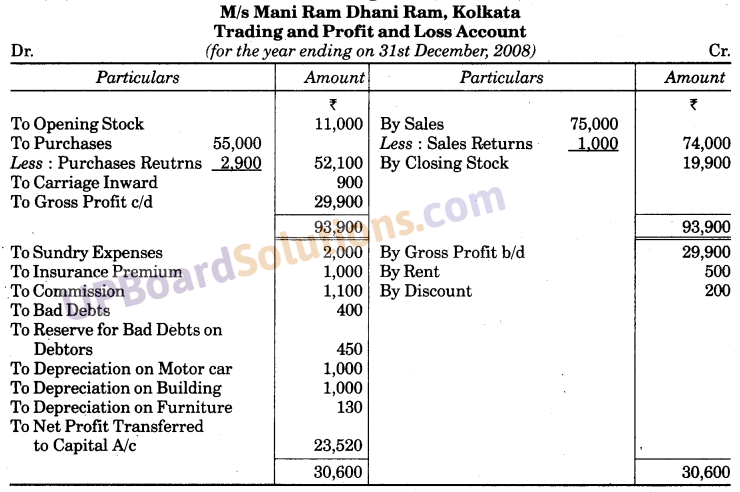

![]()
Question 15.
Pass Journal entries in proper form for the following adjustments:
(i) Outstanding salaries of the employees are Rs. 6,000.
(ii) Prepaid Insurance premium is Rs. 1,500.
(iii) Interest accrued @ 6% on Capital Rs. 1,00,000.
(iv) Depreciation accrued @ 10% on Building Rs. 1,50,000.
(v) Commission accrued is Rs. 400. (UP 2009)
Solution:

Question 16.
From the following information, prepare Balance Sheet of M/s Krishna B alar am, Ballia as on 31st December, 2008:
Cash in hand Rs. 11,400; Cash at BankRs. 15,300; Debtors Rs. 50,000; Creditors Rs. 20,000; Bills Receivable Rs. 15,000; Bills Payable Rs. 11,000; Capital Rs. 1,75,000; Machinery Rs. 50,000; Building Rs. 2,75,000; Closing Stock Rs. 30,000; Furniture Rs. 25,000; General Reserve Rs. 20,000 and Net Profit Rs. 2,25,200.
Other Information:
Net profit was calculated after taking into consideration the following adjustments:
(i) Interest on Capital @ 6% per annum.
(ii) Depreciation on Machinery and Furniture @ 10% per annual.
(iii) Reserve for Bad and Doubtful Debts on Debtors @ 5%. (UP 2009)
Solution:

![]()
Question 17.
From the following Trial Balance of M/s Ghasiram Patiram, prepare Trading Account and Profit and Loss Account for the year ended 31st December 2009 and Balance Sheet as on that date:

On 31st December, cost of stock was Rs. 30,000. Charge depreciation on machinery @ 10%. Make reserve for Bad and Doubtful Debts @ 5% on debtors and charge interest on capital @ 6%. Salaries of Rs. 1,000 are prepaid.
Or
From the following information, prepare profit and loss account pff M/s Aajani & Brothers for the year ended 31st December, 2009: Debtors Rs. 50,000; Received Discount Rs. 750; Repair Rs. 200; Reserve for Doubtful (UPBoardSolutions.com) Debts Rs. 1,025; Machinery Rs. 20,000; Cash Rs. 5,000; Deposit in Bank Rs. 1,000; Advertisement Expenses Rs. 10,000; Gross Profit Rs. 59,000; Creditors Rs. 35,000; Capital Rs. 40,000; Drawing Rs. 9,000; Insurance Premium Annually Rs. 2,000.
Adjustments:
(i) Bad Debts on Debtors Rs. 1,000; Reserve for Bad Debts @ 5%;
(ii) Interest on Capital and Drawing @ 6%;
(iii) Written off 1/5 of Advertisement;
(iv) Insurance Premium is prepaid for 3 months. (UP 2010)
Solution:

![]()

Question 18.
From the following Trial Balance of M/s Dhani Ram Nirdhan Ram, prepare Trading Account and Profit and Loss Account for the year ending on 31st December 2010 and its Balance Sheet as on that date:

Adjustments:
(i) Closing stock: Rs. 46,000.
(ii) Outstanding wages: Rs. 1,600.
(iii) Prepaid insurance: Rs. 600
(iv) Depreciation on building @ 12%. (UP 2011)
Solution:



